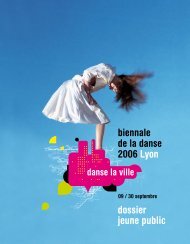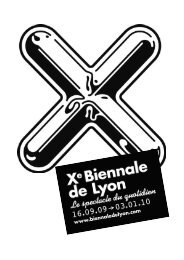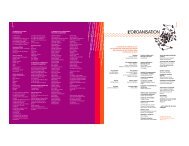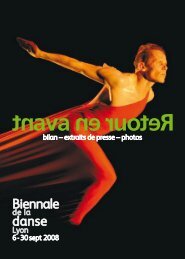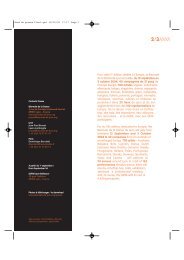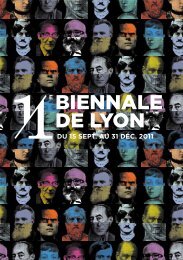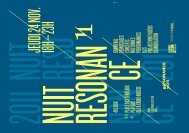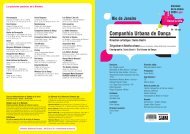Ballet PreljocajB<strong>la</strong>nche NeigePièce pour 26 danseurs - Création 2008Chorégraphie : Angelin PreljocajMusique : Gustav MahlerCostumes : Jean-Paul Gaultier - Décors : Thierry Leproust - Vidéo : Gilles Papain - Assistant, adjoint à <strong>la</strong> direction artistique : Youri Van d<strong>en</strong> Bosch - Assistante répétitrice : C<strong>la</strong>udia De SmetChoréologue : Dany LévêqueCoproduction : Bi<strong>en</strong>nale <strong>de</strong> <strong>la</strong> <strong>Danse</strong> <strong>de</strong> <strong>Lyon</strong> / Conseil général du Rhône, Théâtre National <strong>de</strong> Chaillot, Grand Théâtre <strong>de</strong> Prov<strong>en</strong>ce, le Duo Dijon, Staatsballet Berlin (Allemagne), Fondazione I TeatriRED / RPF (Reggio Emilia, Italie). Le Ballet Preljocaj, C<strong>en</strong>tre Chorégraphique National est subv<strong>en</strong>tionné par le Ministère <strong>de</strong> <strong>la</strong> culture et <strong>de</strong> <strong>la</strong> communication - DRAC PACA, <strong>la</strong> Région Prov<strong>en</strong>ce-Alpes-Côte d’Azur, le Départem<strong>en</strong>t <strong>de</strong>s Bouches-du-Rhône, <strong>la</strong> Communauté du Pays d’Aix et <strong>la</strong> Ville d’Aix-<strong>en</strong>-Prov<strong>en</strong>ce et reçoit le souti<strong>en</strong> <strong>de</strong> : Groupe Partouche - Casino Municipal d’Aix-Thermal,Groupama-Alpes Mediterranée pour le développem<strong>en</strong>t <strong>de</strong> ses projets et <strong>de</strong> Culturesfrance - Ministère <strong>de</strong>s Affaires étrangères pour certaines <strong>de</strong> ses tournées à l’étranger.Avec le souti<strong>en</strong> <strong>de</strong> <strong>la</strong> Région Rhône-Alpes dans le cadre <strong>de</strong> l’Appel à Projet Spectacle Vivant.Accueil : Maison <strong>de</strong> <strong>la</strong> <strong>Danse</strong>, Bi<strong>en</strong>nale <strong>de</strong> <strong>la</strong> <strong>Danse</strong>Maison <strong>de</strong> <strong>la</strong> <strong>Danse</strong>Jeudi 25 20h30V<strong>en</strong>dredi 26 20h30Samedi 27 20h30Dimanche 28 17hMardi 30 20h30En octobreMercredi 1 19h30Jeudi 2 20h30V<strong>en</strong>dredi 3 20h30Samedi 4 15hSamedi 4 20h30Durée : 2h20Plein tarif1 ère série 35 €2 ème série 29 €Tarif réduit1 ère série 32 €2 ème série 26 €Angelin PreljocajNé <strong>en</strong> <strong>France</strong>, <strong>de</strong> par<strong>en</strong>ts albanais, AngelinPreljocaj débute <strong>de</strong>s étu<strong>de</strong>s <strong>de</strong> dansec<strong>la</strong>ssique avant <strong>de</strong> se tourner vers <strong>la</strong> dansecontemporaine auprès <strong>de</strong> Karin Waehner.En 1980, il part pour New York afin <strong>de</strong>travailler avec Z<strong>en</strong>a Rommett et Merce Cunningham,puis continue ses étu<strong>de</strong>s <strong>en</strong> <strong>France</strong>auprès <strong>de</strong> <strong>la</strong> chorégraphe américaine Vio<strong>la</strong>Farber et Qu<strong>en</strong>tin Rouillier. Il rejoint <strong>en</strong>suiteDominique Bagouet jusqu’à <strong>la</strong> création <strong>de</strong>sa propre compagnie <strong>en</strong> décembre 1984. Il achorégraphié <strong>de</strong>puis 38 pièces, du duo auxgran<strong>de</strong>s formes.Angelin Preljocaj s’associe régulièrem<strong>en</strong>tavec d’autres artistes parmi lesquels EnkiBi<strong>la</strong>l (Roméo et Juliette, 1990), GoranVejvoda (Paysage après <strong>la</strong> bataille, 1997),Air (Near Life Experi<strong>en</strong>ce, 2003), Granu<strong>la</strong>rSynthesis («N», 2004), Fabrice Hyber (Les4 saisons…, 2005), Karlheinz Stockhaus<strong>en</strong>(Eldorado - Sonntags Abschied, 2007)…Ses créations sont reprises au répertoire<strong>de</strong> nombreuses compagnies, dont il reçoitégalem<strong>en</strong>t <strong>de</strong>s comman<strong>de</strong>s, c’est le casnotamm<strong>en</strong>t du Ballet <strong>de</strong> l’Opéra national <strong>de</strong>Paris, <strong>de</strong> La Sca<strong>la</strong> <strong>de</strong> Mi<strong>la</strong>n ou du New YorkCity Ballet.Il a réalisé <strong>de</strong>s courts-métrages (Le postier,Idées noires <strong>en</strong> 1991) et plusieurs films,notamm<strong>en</strong>t Un Trait d’Union et Annonciation(1992 et 2003) pour lesquels il a reçu,<strong>en</strong>tre autres, le “Grand Prix du Film d’Art »<strong>en</strong> 2003, le « Premier prix Vidéo-danse » <strong>en</strong>1992 et celui du Festival <strong>de</strong> Vidéo <strong>de</strong> Prague<strong>en</strong> 1993. Il a égalem<strong>en</strong>t col<strong>la</strong>boré à plusieursréalisations cinématographiques mettant <strong>en</strong>scène ses propres chorégraphies : Les Raboteursavec Cyril Col<strong>la</strong>rd d’après l’œuvre <strong>de</strong>Gustave Caillebotte <strong>en</strong> 1988, Pavillon Noiravec Pierre Coulibeuf <strong>en</strong> 2006 et <strong>en</strong> 2007Eldorado/ Preljocaj avec Olivier Assayas.Plusieurs ouvrages ont été édités autour <strong>de</strong>son travail, notamm<strong>en</strong>t Angelin Preljocaj <strong>en</strong>2003, Pavillon Noir <strong>en</strong> 2006.Au cours <strong>de</strong> sa carrière, Angelin Preljocaja reçu plusieurs reconnaissances parmilesquelles le « Grand Prix National <strong>de</strong> <strong>la</strong>danse » décerné par le Ministère <strong>de</strong> <strong>la</strong>culture <strong>en</strong> 1992, le « B<strong>en</strong>ois <strong>de</strong> <strong>la</strong> danse »pour Le Parc <strong>en</strong> 1995, le « Bessie Award »pour Annonciation <strong>en</strong> 1997, « Les Victoires<strong>de</strong> <strong>la</strong> musique » pour Roméo et Juliette <strong>en</strong>1997. Il est Officier <strong>de</strong>s Arts et <strong>de</strong>s Lettres,Chevalier <strong>de</strong> <strong>la</strong> Légion d’honneur et a éténommé Officier <strong>de</strong> l’ordre du Mérite <strong>en</strong> mai2006.B<strong>la</strong>nche Neige / CréationJ’avais très <strong>en</strong>vie <strong>de</strong> raconter une histoire.Dernièrem<strong>en</strong>t, avec Empty moves puis Eldoradoj’ai conçu <strong>de</strong>s pièces très abstraites et,comme souv<strong>en</strong>t, j’avais le désir <strong>de</strong> pr<strong>en</strong>drele contre-pied, d’écrire quelque chose <strong>de</strong>très concret et d’ouvrir une par<strong>en</strong>thèseféerique et <strong>en</strong>chantée. Pour ne pas tomberdans mes propres ornières sans doute.Et aussi parce que, comme tout le mon<strong>de</strong>,j’adore les histoires.B<strong>la</strong>nche Neige est un ballet narratif, avecune dramaturgie. Les lieux y sont représ<strong>en</strong>téspar les décors <strong>de</strong> Thierry Leproust. Lesdanseurs incarn<strong>en</strong>t les personnages dans<strong>de</strong>s costumes <strong>de</strong> Jean-Paul Gaultier. Ce n’estpas Le mythe ou La lég<strong>en</strong><strong>de</strong> <strong>de</strong> B<strong>la</strong>ncheNeige mais bel et bi<strong>en</strong> B<strong>la</strong>nche Neige. C’estvraim<strong>en</strong>t son histoire…Raconter une histoire avec <strong>la</strong> danse estdélicat et c’est ce<strong>la</strong> qui est passionnant.Comm<strong>en</strong>t faire compr<strong>en</strong>dre l’histoire ? DansL’Anoure, j’avais choisi <strong>de</strong> faire <strong>en</strong>t<strong>en</strong>dre letexte <strong>de</strong> Pascal Quignard dans <strong>la</strong> ban<strong>de</strong> son.Mais avec B<strong>la</strong>nche Neige, je me repose surun argum<strong>en</strong>t que tout le mon<strong>de</strong> connaît,ce qui me permet <strong>de</strong> me conc<strong>en</strong>trer sur ceque dis<strong>en</strong>t les corps, les énergies, l’espaceet sur ce que les personnages ress<strong>en</strong>t<strong>en</strong>t etéprouv<strong>en</strong>t afin <strong>de</strong> donner à voir <strong>la</strong> seuletransc<strong>en</strong>dance <strong>de</strong>s corps. Et puis B<strong>la</strong>ncheNeige conti<strong>en</strong>t <strong>de</strong>s objets merveilleux pourl’imaginaire d’un chorégraphe : <strong>la</strong> pommeou le miroir.Je suis fidèle à <strong>la</strong> version <strong>de</strong>s frères Grimm,à quelques variations personnelles près,fondées sur mon analyse <strong>de</strong>s symboles duconte. Bettelheim décrit B<strong>la</strong>nche Neigecomme le lieu d’un Œdipe inversé. Lamarâtre est sans doute le personnagec<strong>en</strong>tral du conte. C’est elle aussi que j’interrogeà travers sa volonté narcissique <strong>de</strong> nepas r<strong>en</strong>oncer à <strong>la</strong> séduction et à sa p<strong>la</strong>ce <strong>de</strong>femme, quitte à sacrifier sa belle fille.L’intellig<strong>en</strong>ce <strong>de</strong>s symboles apparti<strong>en</strong>t auxadultes autant qu’aux <strong>en</strong>fants, elle parle à66
tous et c’est pour ce<strong>la</strong> que j’aime les contes.Ce ballet contemporain et romantique revêtune importance particulière pour moi – et jerev<strong>en</strong>dique le terme <strong>de</strong> « ballet »- puisqu’ilréunira les 26 danseurs <strong>de</strong> <strong>la</strong> compagnie.Ils danseront sur les symphonies <strong>de</strong> Mahlerdont les débor<strong>de</strong>m<strong>en</strong>ts magnifiques sontd’ess<strong>en</strong>ce romantique. Historiquem<strong>en</strong>t, lescontes <strong>de</strong> Grimm le sont aussi, même si leurstyle épuré nous ramène à une forme <strong>de</strong>contemporanéité.C’est une <strong>en</strong>treprise délicate que <strong>de</strong> chercherà émouvoir. La musique <strong>de</strong> Malher està manipuler avec une imm<strong>en</strong>se précautionmais c’est aujourd’hui un risque que j’ai<strong>en</strong>vie <strong>de</strong> pr<strong>en</strong>dre, celui <strong>de</strong> créer un grandballet contemporain… et romantique.Angelin Preljocaj,Entreti<strong>en</strong> avec Agnès Freschel, Mars 2008Info +Première mondialeCoproduction Bi<strong>en</strong>naleCompagnie invitée <strong>en</strong> 1990www.preljocaj.orgAngelin PreljocajBorn in <strong>France</strong> to Albanian par<strong>en</strong>ts, AngelinPreljocaj began studying c<strong>la</strong>ssical dance beforeswitching to contemporary dance with KarinWaehner. In 1980 he moved to New York towork with Z<strong>en</strong>a Rommett and Merce Cunningham,th<strong>en</strong> continued his studies in <strong>France</strong> withAmerican choreographer Vio<strong>la</strong> Farber and withQu<strong>en</strong>tin Rouillier. He th<strong>en</strong> joined DominiqueBagouet before founding his own company inDecember 1984. He has since choreographed 38pieces, from duets to <strong>la</strong>rge <strong>en</strong>semble works.Angelin Preljocaj regu<strong>la</strong>rly teams with otherartists including Enki Bi<strong>la</strong>l (Roméo et Juliette,1990), Goran Vejvoda (Paysage après <strong>la</strong> bataille,1997), Air (Near Life Experi<strong>en</strong>ce, 2003), Granu<strong>la</strong>rSynthesis (N, 2004), Fabrice Hyber (Les 4saisons…, 2005), and Karlheinz Stockhaus<strong>en</strong>(Eldorado - Sonntags Abschied, 2007).His creations feature in many companies’ repertoires;he also receives commissions, notablyfrom Ballet <strong>de</strong> l’Opéra National <strong>de</strong> Paris, fromLa Sca<strong>la</strong> in Mi<strong>la</strong>n, and from New York City Ballet.He has directed short films (Le postier and Idéesnoires in 1991) and feature films, notably UnTrait d’Union and Annonciation (1992, 2003)which earned him, among other acco<strong>la</strong><strong>de</strong>s, theGrand Prix du Film d’Art (2003), the PremierPrix Vidéo-<strong>Danse</strong> (1992) and the Prague Vi<strong>de</strong>oFestival Award (1993). He has also col<strong>la</strong>boratedon several film productions, directing his ownchoreographies: Cyril Col<strong>la</strong>rd’s Les Raboteursafter Gustave Caillebotte’s painting, 1988; PierreCoulibeuf’s Pavillon Noir, in 2006; and OlivierAssayas’ Eldorado/Preljocaj in 2007.Several books about his work have be<strong>en</strong>published, in particu<strong>la</strong>r Angelin Preljocaj (2003)and Pavillon Noir (2006).In the course of his career, Preljocaj has receivedseveral distinctions including the Grand PrixNational <strong>de</strong> <strong>la</strong> <strong>Danse</strong> awar<strong>de</strong>d by the Fr<strong>en</strong>chMinistry of Culture in 1992; the Prix B<strong>en</strong>ois <strong>de</strong><strong>la</strong> <strong>Danse</strong> for Le Parc in 1995; the Bessie Awardfor Annonciation in 1997; and a Victoire <strong>de</strong> <strong>la</strong>Musique for Roméo et Juliette in 1997. He is anOfficier <strong>de</strong>s Arts et <strong>de</strong>s Lettres, a Chevalier <strong>de</strong><strong>la</strong> Légion d’Honneur, and in May 206 he wasnamed an Officier <strong>de</strong> l’Ordre du Mérite.B<strong>la</strong>nche Neige / Premiering atthe Bi<strong>en</strong>naleI was really ke<strong>en</strong> to tell a story. Rec<strong>en</strong>tly I hadcreated some very abstract pieces – EmptyMoves, th<strong>en</strong> Eldorado – and, as oft<strong>en</strong> happ<strong>en</strong>s,I felt like doing the exact opposite, writingsomething very concrete and having a magical,fairy-world interlu<strong>de</strong>. To not get stuck in a rut,no doubt. And also because, like everyone, I lovefolk and fairy tales.B<strong>la</strong>nche Neige is a narrative ballet giv<strong>en</strong> adramatic treatm<strong>en</strong>t. The locations are repres<strong>en</strong>tedby Thierry Leproust’s sets. The dancers p<strong>la</strong>ycharacters in costumes by Jean-Paul Gaultier. It’snot Le mythe or La lég<strong>en</strong><strong>de</strong> <strong>de</strong> B<strong>la</strong>nche Neige,it’s just B<strong>la</strong>nche Neige. It’s really Snow White’sstory…Telling a story with dance is a tricky affair, whichis why it’s so fascinating. How do you exp<strong>la</strong>in thestory? In L’Anoure, I put Pascal Quignard’s texton the soundtrack. But with B<strong>la</strong>nche Neige, Irely on the argum<strong>en</strong>t that everyone knows whathapp<strong>en</strong>s, so I can focus on what’s expressed bythe bodies, the <strong>en</strong>ergies and the space, and onwhat the characters feel and go through, so thatI only show the bodies transc<strong>en</strong>ding themselves.And besi<strong>de</strong>s, the story contains some won<strong>de</strong>rfulobjects for a choreographer’s imagination – theapple, the mirror...I’m faithful to the Brothers Grimm’s version, exceptfor a few personal variations, based on myown analysis of the tale’s symbols. Bettelheim<strong>de</strong>scribed it as a case of an inverted Oedipuscomplex. The stepmother is <strong>de</strong>finitely the c<strong>en</strong>tralcharacter. And I explore her through her narcissisticwish to avoid giving up seduction and herwoman’s p<strong>la</strong>ce, ev<strong>en</strong> if it means sacrificing herstepdaughter.The intellig<strong>en</strong>ce of symbols belongs as much toadults as to childr<strong>en</strong>. It speaks to us all, and thatis why I love these tales.This contemporary, romantic ballet is particu<strong>la</strong>rlyimportant to me – and I use the word “ballet”<strong>de</strong>liberately – because it brings together thecompany’s 26 dancers. They will dance to Mahler’ssymphonies, whose magnific<strong>en</strong>t flourishesare ess<strong>en</strong>tially romantic. So are the Grimms’tales, historically speaking, ev<strong>en</strong> though theirpared-down style brings us back, in a s<strong>en</strong>se, topres<strong>en</strong>t times.Seeking to touch an audi<strong>en</strong>ce’s emotions isa <strong>de</strong>licate <strong>en</strong>terprise. Mahler’s music must behandled with imm<strong>en</strong>se care, but it’s a risk I feltlike taking – creating a full-l<strong>en</strong>gth ballet that iscontemporary… and romantic.Angelin PreljocajInterview with Agnès FreschelMarch 2008Comm<strong>en</strong>t le passé peut-il <strong>de</strong>ssiner le futur ?How can the past shape the future?Extra info :World premiereCo-produced by the Bi<strong>en</strong>naleThe company performed at the 1990Bi<strong>en</strong>nalewww.preljocaj.org67






